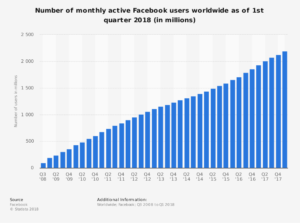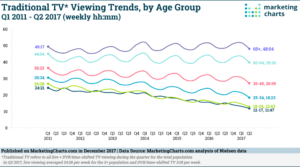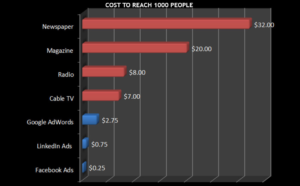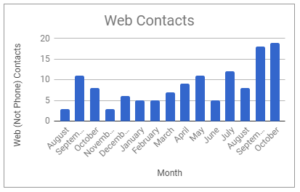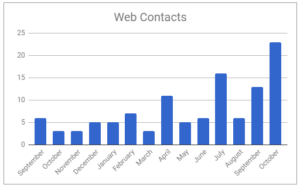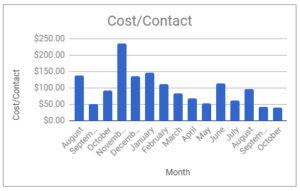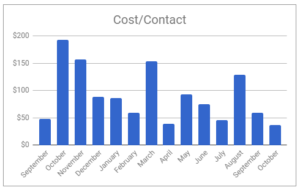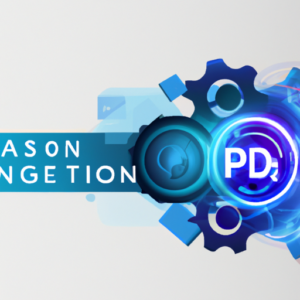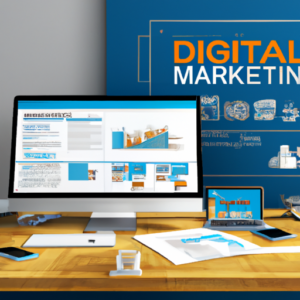At Optimized Marketing, we get this question a lot from Culligan dealers:
I’m hearing a lot about Facebook marketing. Should I be on Facebook? Does it work for water treatment?
Well, let me start with a quick spoiler. Facebook definitely CAN work for Culligan dealers, if you do it the right way. We have a client whose Facebook results are summed up by this table:
| Cost | Leads | Sales | Revenue | Cost/Lead | Cost/Sale | ROAS |
|---|---|---|---|---|---|---|
| $11,004 | 208 | 28 | $145,692 | $52.90 | $392.99 | 13.2 |
In other words, they spent $11k on Facebook and generated about $145.5k in revenue. That’s an ROAS (return on ad spend) of 13.2, which means that for every $1 they spent on Facebook they made $13.20.
They also generated 208 leads (yes, leads, not contacts).
So…that sounds pretty good, right? Does that mean you should stop all your other marketing and bet it all on Facebook?
Well, hold on there cowboy. It’s not all sunshine and roses.
Facebook, like any marketing channel, has its own pros and cons. Things that it does really well, and things that it doesn’t do so well.
In this article we’ll cover what some of those quirks are, and what our experience has been in using Facebook to market water treatment systems. Hopefully this information will help you make a better decision on whether or not this is something that would make sense for your company.
Facebook Gives You A Way Of Generating NEW Leads
One of the first things to realize about Facebook, and this is a pretty big deal, is that we can reach just about anybody in your PAR using Facebook.
Even if they’re not currently searching for you online.
That’s one big limitation of Google Ads. With Google, you can easily get in front of people who search for “water softener”…
But that doesn’t do much good to all the other people who aren’t searching for water softener.
Now don’t get me wrong: Google ads work great. Particularly because people who are searching for “water softeners” tend to make pretty good prospects, for obvious reasons.
All I’m saying is that Google Ads has a built-in limit. You can only display your Google Search Ads to people who are actually searching.
But with Facebook? Those limits go out the window.
First of all, consider the enormous reach Facebook has:
You can show your ads to just about everybody in your area, if you want to. Whether they’re looking for water treatment or not.
Which means that Facebook gives you a tremendous ability to scale up your marketing campaigns to reach more people, generate new customers, and grow your business.
Facebook Lets You Target A Wide Variety of People
I just said that if you wanted, you could target everybody in your area.
But of course we wouldn’t really do that. We only want to show your ads to the people who are most likely to respond.
Luckily for us marketers, Facebook has a gigantic database with all kinds of information about us. It knows what we like, the kinds of links we click on, how much money we make, whether we own or rent our home, who our friends are, and so on.
And you use a lot of these qualities to narrow down your Facebook ads to reach specific kinds of people.
For instance, you could serve ads to people who show an interest in well water. Or drinking water.
You could limit your ads by demographics, or even to certain geographic areas where you know there’s a lot of problem water.
And you can combine this targeting ability with equally targeted ads–for instance, by writing ads focused on how important it is for new children to have high-quality drinking water. Then serving that ad to new parents.
Or targeting new homebuyers with ads that talk about how soft water can prolong the lifespan of your pipes and appliances.
Or writing ads about how important drinking water is to your health, and targeting people with an interest in healthy diet.
These are just a few of the first things we tried on Facebook. With all the data available on this platform, you can be really creative in getting a tailor-written message in front of a specific group of people.
You Can Get In Front of People in a Place Where They’re Paying Attention
These days, marketing messages are everywhere.
E-V-E-R-Y-W-H-E-R-E.
Data suggests the average person sees over 2,000 advertisements every day.
And as a result, people have learned how to cultivate a sort of selective blindness when it comes to most forms of advertising. (Which helps explain why the average person recalls only about 3% of the ads they see.)
TV ads? Most people (especially younger generations) will DVR their shows and skip the commercials. That is, if they haven’t canceled their TV service and switched to streaming services like Netflix and Hulu, which more and more people are doing (especially those under 50):
Radio? I don’t know about you, but I listen to a lot more audio from my phone than radio these days (music, podcasts, audio books). And when I do use the radio, I change the station anytime a commercial comes on.
Banner ads? These are almost completely ignored by almost everybody, everywhere. It’s gotten so bad that “banner blindness” is officially a thing.
But Facebook?
On Facebook, people are still paying attention.
One great thing about Facebook ads is that they show up right inside the person’s newsfeed, sandwiched in between your brother’s birthday announcement and pictures from your cousin’s wedding.
This is some prime real estate, people. This is a place where people pay attention. And your ad isn’t off to the side like it is on most websites. It’s right smack dab in the middle of their screen.
And if you design your ad very carefully, it won’t even look like an ad…making people that much more likely to engage with it.
Facebook Supports a Wide Variety of Ad Types
On Google Ads, you have the choice between text ads and expanded text ads.
(Just kidding…text ads are no longer supported.)
In other words, every ad looks the same. Lots of words.
But on Facebook you can do all kinds of things. Image ads that go back to your website…
Video ads that open up a pre-programmed chatbot conversation…
Lead ads that pop up a web form in which the person’s name, email, & phone number are automatically filled out.
With all these different kinds of ads, we can test all sorts of things to grab people’s attention. And thanks to Facebook’s powerful ability to create new audiences, we can even show people several different ads in a specific order.
For instance, maybe we start with a water softener video ad from one of corporate’s new campaigns.
Then we could show another water softener ad to all the people who watched at least 50% of that first video. We might choose to make that second ad more specific, getting into more of the details and benefits of using a Culligan water softener.
And we can even retarget all the people who clicked on that second ad with a third ad, asking them if they have any questions. All they have to do is click a button on the ad, and Facebook Messenger will open up–where you can answer all their questions in real-time.
All this is just to say that we can do a lot of things on Facebook, from branding to direct response and everything in-between, making it an extremely exciting platform for marketers.
It’s a Cheaper Source of Traffic than Google Ads
Depending on the market and the competition, our clients often pay in the range of $4 per click for a Google Ads visitor. Obviously that can be a lot higher or lower depending on the keyword, but $4 is a ballpark average.
In Facebook, though? We’re paying the equivalent of a $1 cost per click. That makes it 75% cheaper. And that’s pretty awesome.
And compared to other sources of advertising (especially offline sources), Facebook is far, FAR less expensive:
Although to be fair, Google traffic may lead to higher-quality leads…which brings me to my next point:
Facebook Leads May Be Harder To Sell To
Now let’s look at something that may prove to be the biggest downside of Facebook:
The lead quality may be lower than it is for some of your other sources.
Let’s take another look at those stats from the beginning of the article:
| Cost | Leads | Sales | Revenue | Cost/Lead | Cost/Sale | ROAS |
|---|---|---|---|---|---|---|
| $11,004 | 208 | 28 | $145,692 | $52.90 | $392.99 | 13.2 |
As you can see, they turned 208 leads into 28 sales. That’s a 13% closing rate.
For comparison, during last October that same client turned 348 leads from other sources into 147 sales…which is a 42% closing rate.
So their closing rate for Facebook leads is about 70% less than it is for other leads.
That sounds bad, but keep in mind that Facebook is also 75% cheaper than Google. It doesn’t have to convert as well. It just needs to convert well enough to give you a good ROI on your investment.
Now in this particular case, even though they closed only 13% of leads, Facebook still proved to be an effective source of revenue because the volume and cost of leads was low enough to make those numbers work.
This is one area where we’re continuing to work on ways to improve. It could be that Facebook traffic just requires a different sort of follow-up compared to other leads. A Facebook user may be less likely to answer their phone, but more likely to reply to an email or text. So we’re doing our best to test different things to help improve the closing rate for Facebook leads–like setting up automated email follow-up and giving clients the ability to send text messages to contacts who don’t answer the phone.
Our Testing Suggests That Some Markets May Be More Facebook-Friendly Than Others
We’ve had a fair number of clients give Facebook a try. And in some cases (like the example above), the results were really encouraging.
But not everyone got the same great results. Some dealers have been getting great results on Facebook, and some have gotten so-so results, and one or two have had trouble getting any traction at all.
(Even when we ran the exact same ads to the exact same audiences.)
What’s the difference?
Certainly the water quality is a big factor here. If you live in a hard-water market, we’re going to have more success marketing softeners on Facebook. That just makes sense.
The size of your area is another thing that pays a role. If you’re located in a large market, you have a definite advantage on Facebook. (Facebook’s algorithm works best when it has a lot of data to work with–which means that people in very small markets might have a hard time getting Facebook to work.)
We’re Still Learning A Lot
The last thing I want to emphasize is that we’re still learning. A lot.
Unlike Google Ads, which has been around for a good 15 years, Facebook marketing is extremely new. And while Google Ads has gotten to the point where it’s relatively stable, Facebook is still making a lot of big changes to their ad platform.
We’ve spent years optimizing Google Ads. We’ve designed carefully thought-out systems and even developed our own custom scripts to automate some of the most important processes.
But with Facebook, while we’ve already run over 300 ads to dozens of different audiences, we still have a lot more ideas to try and insights to learn.
The good news here is that there’s potential for growth, including more low-hanging fruit than there is on Google. And I expect that over the next 2-3 years, that potential will result in a whole slew of new leads and sales for North American Culligan dealers.
You can already see how we’ve improved over the past year or so in terms of generating more contacts from Facebook:
At a better cost/contact:
If you’d like to be among those dealers benefitting from our proprietary Facebook marketing funnels, get in touch with us and ask us about Facebook marketing. We’ll be happy to jump on a call and go over some ideas about how we can help grow your business with better Facebook marketing.

